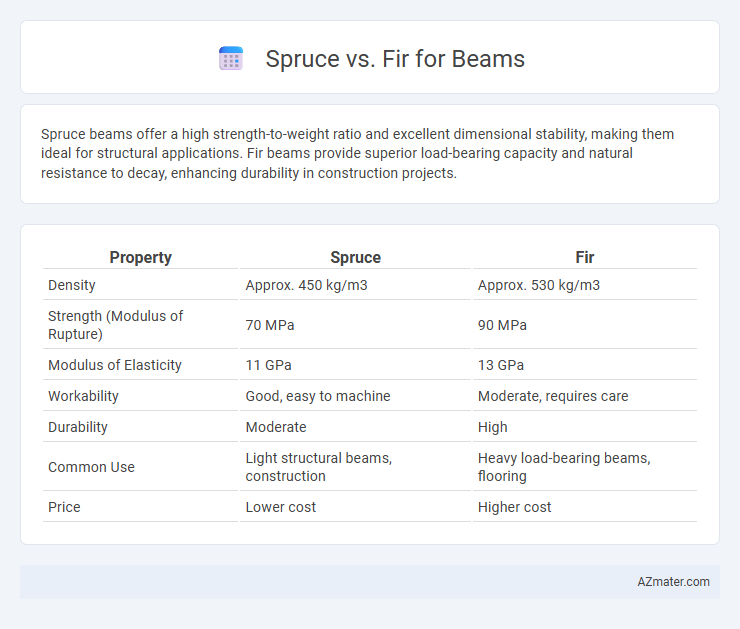Spruce beams offer a high strength-to-weight ratio and excellent dimensional stability, making them ideal for structural applications. Fir beams provide superior load-bearing capacity and natural resistance to decay, enhancing durability in construction projects.
Table of Comparison
| Property | Spruce | Fir |
|---|---|---|
| Density | Approx. 450 kg/m3 | Approx. 530 kg/m3 |
| Strength (Modulus of Rupture) | 70 MPa | 90 MPa |
| Modulus of Elasticity | 11 GPa | 13 GPa |
| Workability | Good, easy to machine | Moderate, requires care |
| Durability | Moderate | High |
| Common Use | Light structural beams, construction | Heavy load-bearing beams, flooring |
| Price | Lower cost | Higher cost |
Introduction to Spruce and Fir Beams
Spruce and fir beams are widely used in construction due to their strength-to-weight ratio and workability. Spruce beams offer excellent structural performance with a straight grain and low resin content, making them ideal for load-bearing applications. Fir beams provide notable durability and resistance to warping, often preferred for framing in residential and commercial buildings.
Botanical Differences Between Spruce and Fir
Spruce trees belong to the genus Picea and feature needle-like leaves attached individually to small peg-like structures, giving them a rough texture, whereas firs, from the genus Abies, have softer, flat needles attached directly to the twig, creating a smoother surface. Spruce needles are typically four-sided and can be easily rolled between fingers, contrasting with fir needles which are flat and possess two white stomatal bands underneath. These botanical distinctions influence their wood properties, with spruce generally producing lighter, softer timber suitable for beams, and fir offering a denser, stronger wood favored in structural applications.
Physical Properties: Strength and Density
Spruce beams typically offer a higher strength-to-weight ratio compared to fir, making them ideal for structural applications requiring durability without excessive weight. Fir possesses a greater density than spruce, contributing to its enhanced load-bearing capacity and resistance to compression under heavy loads. Both woods provide excellent dimensional stability, but spruce's lower density allows for easier handling and installation in construction projects.
Workability and Ease of Handling
Spruce beams offer superior workability due to their fine grain and consistent texture, making them easier to cut, nail, and shape compared to fir. Fir tends to be denser and harder, which can complicate handling and machining but provides greater strength and rigidity. For projects prioritizing ease of handling and smooth finish with hand or power tools, spruce is often preferred over fir.
Durability and Resistance to Decay
Spruce beams are valued for their strength-to-weight ratio but exhibit moderate durability and lower resistance to decay compared to fir. Fir beams, especially Douglas fir, offer superior durability and enhanced resistance to decay, making them ideal for structural applications exposed to moisture. Fir's natural resin content and dense grain contribute to its longevity in outdoor and load-bearing construction.
Cost Comparison of Spruce vs Fir
Spruce beams generally offer a more cost-effective solution compared to fir due to their wider availability and faster growth rates, which reduce material expenses. Fir beams tend to be pricier because of their higher density and superior strength, making them a preferred choice for projects requiring durability and structural integrity. Budget-conscious builders often choose spruce for large-scale construction projects to optimize cost without significantly compromising performance.
Appearance and Grain Pattern
Spruce beams are known for their pale, creamy color with a straight, uniform grain pattern that provides a clean, consistent appearance ideal for modern, minimalistic designs. Fir beams, particularly Douglas fir, display a richer, reddish-brown hue with a more pronounced and varied grain pattern, offering a warm, rustic aesthetic that highlights natural wood variations. Both spruce and fir serve well structurally, but spruce's subtle grain contrasts with fir's bold, dynamic patterns, influencing the overall visual impact of exposed beams in interior design.
Availability and Sourcing
Spruce beams are widely available in North America and Europe due to extensive forestry and sustainable management practices, making sourcing relatively consistent and cost-effective. Fir beams, especially Douglas fir, are also readily accessible but may come at a higher price point due to their slower growth and greater structural strength, which is favored in construction requiring higher load capacity. Both species benefit from well-established supply chains, but spruce is typically more abundant and easier to procure in larger quantities for general beam applications.
Environmental Impact and Sustainability
Spruce beams offer a lower environmental impact due to faster growth rates and higher carbon sequestration compared to fir, making them a more sustainable choice in construction. Fir beams often come from older, slower-growing trees, potentially contributing to longer forest regeneration times and higher ecological footprints. Choosing spruce supports sustainable forestry practices by promoting efficient resource use and reducing habitat disruption in managed forests.
Best Uses: Choosing the Right Wood for Your Beam
Spruce beams offer excellent strength-to-weight ratio and are ideal for interior structural elements, providing stability and a clean, light finish. Fir beams excel in durability and resistance to warping, making them suitable for outdoor or heavy-load applications where longevity is crucial. Selecting spruce for lightweight framing or fir for exposed beams ensures optimal performance based on project requirements.

Infographic: Spruce vs Fir for Beam
 azmater.com
azmater.com